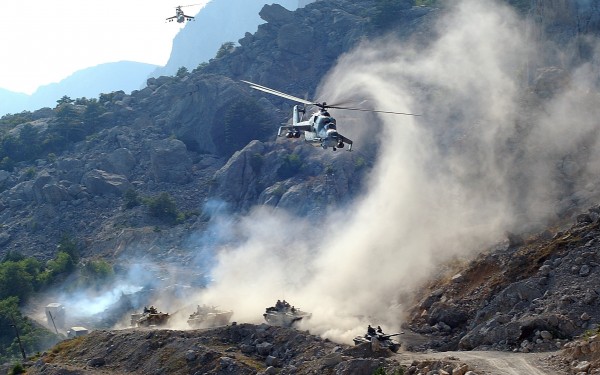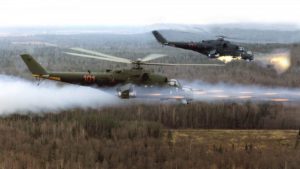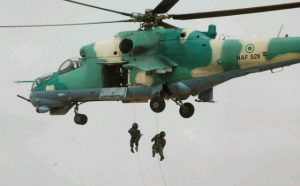Mil Mi-24 – Russian Attack Helicopter
When the Soviet Union developed their Mil M-24 attack helicopter in the late 1960’s, they wanted a military helicopter that could provide close air support to ground troops and still be able to bring in reinforcements and take out casualties. That’s precisely what the Hind can do. The name ‘Hind’ is actually its NATO designation. The Russians call it the ‘Crocodile’ informally. It’s widely considered to be a flying tank or infantry fighting vehicle.

Defenses:
The Mil Mi-24 features an extremely armored cockpit for its pilot and weapons officer as well as a staggering array of internal and external weapons. Its seen action in nearly every conflict that the Soviet Union has engaged in since its first release in 1976. The most notable action was seen in the Soviet occupation of Afghanistan, where it was used to great effect for close air support of troops, attack missions, and medical evacuations.
The main weakness of the Mil Mi-24 is its rotors and engine exhaust ports. While it can withstand a withering rate of small arms fire, man-portable surface-to-air missiles have accounted for the greatest number of Mil Mi-24 losses. Still, the Russian Federation continues to employ the Mil Mi-24 due to its resiliency and mission effectiveness.

Pure Anti-Personnel Attack Helicopter:
Initially, the Mil Mi-24 was closely designed off an existing UH-1 “Huey” that had seen extensive action with the United States Army’s Air Cavalry. The UH-1 Huey was able to lay down suppressive fire with rockets while a door gunner effectively covered infantry deploying from its side hatch. The Mil Mi-24 took the best of the UH-1 design for portability and seemingly advanced ideas laid out with the Apache attack helicopter for a front-emplaced internal machine gun.

Firepower:
The flexible 12.7mm Yakushev-Borzov Yak-B Gatling gun optionally included in the front is a true menace to face. When put into the front pod of the Mil Mi-24, it can be adjusted with an azimuth of 60° to either side, an elevation of 20°, and a depression of 60°. This means it can cover almost directly beneath the helicopter and maneuver to fire within a wide cone.

At an estimated 4000-5000 rounds per minute, the Yak-B has an impressive rate of fire. It is comparable with the American GAU-19. The Yak-B gatling is a gas-operated machine gun mostly effective against troops that are not dug in or behind fortifications. In later models of the Mil Mi-24, the Yak-B gatling gun was replaced with the swivel-mounted Gryazev-Shipunov GSh-23 twin-barreled 23mm autocannon. This proved to be much more effective against light armor and still effective against personnel.
Anti-Tank Capabilities:
Side emplacements on the Mil Mi-24 allowed for the Fleyta or the 9K114 Shturm to be added. Both the Shturm and Fleyta are highly effective radio-guided anti-tank missiles which can be attached to external hardpoints on the Mil Mi-24. This enables the Mil Mi-24 to engage personnel with its internal guns while directing radio-guided missiles to armored targets.

Upgrades:
In 2014, the Russian Federation did a massive overhaul of its existing Mil Mi-24 attack helicopters. The new version, named the Mil Mi-35, bears a close resemblance to its predecessor. The Mil Mi-35M features a modern avionics deck, upgraded turboshafts, and the capacity to load-out new internal armaments.
Powerplant:
The Mil Mi-24 “Crocodile” is powered by two twin Isotov TV3-117 turbines. Each turbine produces up to 2,200 hp (1,600 kW) each.
See Specifications
| Length: 57 ft 4 in (17.5 m) |
| Rotor Diameter: 56 ft 7 in (17.3 m) |
| Wingspan: 21 ft 3 in (6.5 m) |
| Height: 21 ft 3 in (6.5 m) |
| Max. Takeoff Weight: 26,500 lbs. (12,000 kg) |
| Maximum Speed: 208 mph (335 km/h) |
| Range: 280 mi (450 km) |
| Service Ceiling: 16,076 ft (4,900 m) |
| Crew: 2–3; pilot, weapons system officer, and an optional technician slot available |
| Capacity: 8 troops OR up to 4 stretchers or 5,291 lbs. cargo (2400 kg) with external sling |

